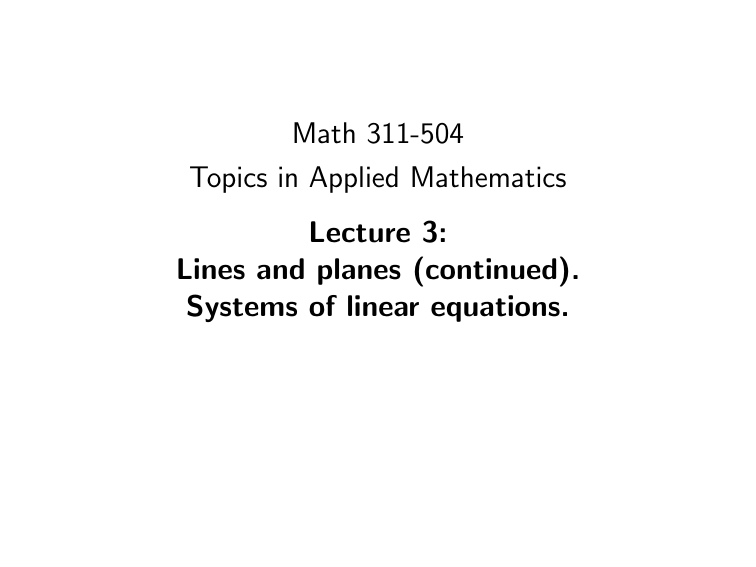Math 311-504 Topics in Applied Mathematics Lecture 3: Lines and planes (continued).
advertisement

Math 311-504 Topics in Applied Mathematics Lecture 3: Lines and planes (continued). Systems of linear equations. Lines Definition. A line in Rn is a set of all points tu + v, where u 6= 0 and v are fixed vectors in Rn while t ranges over all real numbers. tu + v is a parametric representation of the line. In R2 , a line is given by an equation ax + by = c, where a, b, c are constants. The vector (a, b) is orthogonal to the line. Planes Definition. A plane in Rn is a set of all points tu + sw + v, where u, w, and v are fixed vectors in Rn such that u and w are not parallel, while t and s range over all real numbers. tu + sw + v is a parametric representation. In R3 , a plane is given by an equation ax + by + cz = d, where a, b, c, d are constants. The vector (a, b, c) is orthogonal to the plane. Problem 1. Determine whether the point (1, 4) lies on the line t(2, −1) + (−3, 5). We need to check solvability of the equation t(2, −1) + (−3, 5) = (1, 4). This vector equation is equivalent to a system of two scalar equations: 2t − 3 = 1 t=2 ⇐⇒ −t + 5 = 4 t=1 The system has no solution =⇒ the point is not on the line. Problem 2. Find an equation for the line t(2, −1) + (−3, 5). The vector (a, b) is orthogonal to (−b, a) for any a, b ∈ R. Hence the vector (1, 2) is orthogonal to the line. Therefore the equation is 1(x + 3) + 2(y − 5) = 0 or x + 2y = 7. Problem 3. Find a parametric representation for a plane in R3 given by the equation 3x + 2y + z = 5. The equation can be solved for z: z = 5 − 3x − 2y . It follows that the plane has a parametric representation x = t, y = s, t, s ∈ R. z = 5 − 3t − 2s, That is, (x, y , z) = (t, s, 5 − 3t − 2s) = = t(1, 0, −3) + s(0, 1, −2) + (0, 0, 5). Problem 4. Find a parametric representation and an equation for the plane passing through (1, 1, 1) and parallel to the plane 3x + 2y + z = 5. Parametric representation: t(1, 0, −3) + s(0, 1, −2) + (1, 1, 1). Equation: 3x + 2y + z = d, where d is a constant. Since the point (1, 1, 1) is on the plane, we get d = 3 + 2 + 1 = 6. Problem 5. Find the intersection point of the line t(2, −1, 0) + (−3, 5, 0) with the plane 3x + 2y + z = 5. An arbitrary point on the line has coordinates (x, y , z) = t(2, −1, 0) + (−3, 5, 0) = (2t − 3, −t + 5, 0), where t ∈ R. The point belongs to the plane if and only if 3(2t − 3) + 2(−t + 5) + 0 = 5 ⇐⇒ 4t + 1 = 5 ⇐⇒ t = 1. Thus the intersection point is 1(2, −1, 0) + (−3, 5, 0) = (−1, 4, 0). Linear equations An equation ax + by = c, where x, y are variables and a, b, c are constants, is called linear (because it defines a line in R2 ). More generally, a linear equation is any equation of the form a1 x1 + a2 x2 + · · · + an xn = b, where x1 , x2 , . . . , xn are variables and a1 , a2 , . . . , an , b are constants. Systems of linear equations a11 x1 + a12 x2 + · · · + a1n xn = b1 a21 x1 + a22 x2 + · · · + a2n xn = b2 ········· am1 x1 + am2 x2 + · · · + amn xn = bm Here x1 , x2 , . . . , xn are variables and aij , bj are constants. A solution of the system is a common solution of all equations in the system. Plenty of problems in mathematics and applications require solving systems of linear equations. Problem. Find the point of intersection of the lines x − y = −2 and 2x + 3y = 6 in R2 . x − y = −2 x =y −2 ⇐⇒ ⇐⇒ 2x + 3y = 6 2x + 3y = 6 x =y −2 x =y −2 ⇐⇒ ⇐⇒ 2(y − 2) + 3y = 6 5y = 10 x =y −2 x =0 ⇐⇒ y =2 y =2 Solution: the lines intersect at the point (0, 2). Remark. The symbol of equivalence ⇐⇒ means that two systems have the same solutions. y x x − y = −2 2x + 3y = 6 x = 0, y = 2 y x 2x + 3y = 2 2x + 3y = 6 inconsistent system (no solutions) y x 4x + 6y = 12 ⇐⇒ 2x + 3y = 6 2x + 3y = 6 Solving systems of linear equations Elimination method always works for systems of linear equations. Algorithm: (1) pick a variable, solve one of the equations for it, and eliminate it from the other equations; (2) put aside the equation used in the elimination, and return to step (1). The algorithm reduces the number of variables (as well as the number of equations), hence it stops after a finite number of steps. After the algorithm stops, the system is simplified so that it should be clear how to complete solution. Example. =2 x −y 2x − y − z = 3 x +y +z =6 Solve the 1st equation for x: x = y +2 2x − y − z = 3 x +y +z =6 Eliminate x from the 2nd and 3rd equations: x = y +2 2(y + 2) − y − z = 3 (y + 2) + y + z = 6 Simplify: x = y +2 y − z = −1 2y + z = 4 Now the 2nd and 3rd equations form a system of two linear equations in two variables. Solve the 2nd equation for y , then eliminate y from the 3rd equation: x = y + 2 x = y +2 y =z −1 y =z −1 2(z − 1) + z = 4 2y + z = 4 Simplify: x = y +2 y =z −1 3z = 6 The elimination is completed. Now the system is easily solved by back substitution. That is, we find z from the 3rd equation, then substitute it in the 2nd equation and find y , then substitute y and z in the 1st equation and find x. x = y +2 x = y +2 x = 3 y =z −1 y =1 y =1 z =2 z =2 z =2 System of linear equations: =2 x −y 2x − y − z = 3 x +y +z =6 Solution: (x, y , z) = (3, 1, 2)

